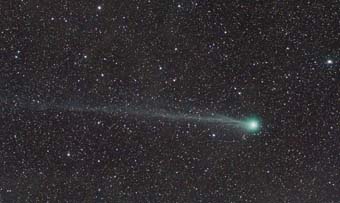
Researchers of the Astronomic Observatory of the Universitat de València have taken a photograph of the Comet Lovejoy in its greatest brightness while it was flying through the night sky from the facilities of this academic institution placed in Aras de los Olmos. Furthermore, the picture shows a curious phenomenon. Against what it could seem, the comet doesn’t move from left to right, it moves from down to up.
“Lovejoy’s tail stays a few thousand million kilometres away from the sun, placed on the right, and it points to the left because solar wind reaches it from the opposite direction. Moreover, it shows disturbances due to the turbulences of solar wind”, the astronomer Fernando Ballesteros clarifies.
The Comet Lovejoy, which has just achieved its greatest brightness this week and it has been seen from the Iberian Peninsula, will start to be seen more and more dim as the Earth and the Comet move away from each other. Lovejoy, which still has to be a little bit closer to the Sun, will reach the perihelion next 30 January, before it starts its return journey to the outer Solar System. “We’ll know nothing about it until around ten thousand years”, the Astronomic Observatory points out.
ITS HUGE DIMENSIONS
Although it can be seen with binoculars, to get a detailed look, it is necessary to take a photograph during a long term exposure and accumulate light in the camera. The picture of the Universitat de València was taken during the dawn of 21 January, with a total exposure of 8 minutes and a telephoto lens Nikon 180mm f/2.8, because Lovejoy is so huge that it can’t be seen completely by using a telescope.
More information: http://observatori.uv.es/
Image credits: Vicent Peris, Òscar Brevià and Satur Martínez. Astronomic Observatory of the Universitat de València.
Last update: 27 de january de 2015 13:49.
News release


















